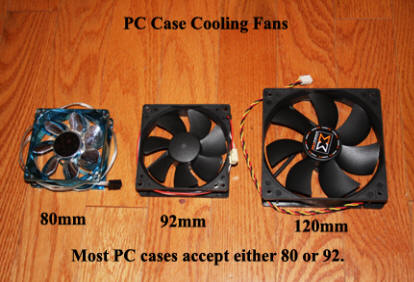
"PC - PC Fans"
Ron Stultz
6 April 2009
Summary: there are many options when it comes to adding fans to a personal computer (PC). Best options include: upgrading CPU fan; adding case fan; adding hard drive fan.
Background:
Fans for use with a PC come in different: sizes; RPMs or cubic feet a minute (CFM) air flow; noise levels and cost.
The first thing that most folks think about when they know they have a PC heat problem is to add one or more fans or to swap out a case fan for a "larger" one but my experience has been that a fan added in a wrong location or of incorrect CFM will do little or nothing for heat reduction and probably will simply increase PC noise.
PC case fans. General: Fans for case mounting come in 3 major sizes: 80, 92 or 120mm. All case mounted fans are 12volts DC. Some motherboards provide 1 or more, 3 pin male connector(s) to which a 3 pin female case fan connector can be attached. The 3 pins are power from the motherboard to the fan (2 pins) and a 1 pin RPM read out from the fan back to the motherboard. RPM feedback from a fan is great but only if the motherboard has the software to sense the fan is no longer turning and alerts the user.

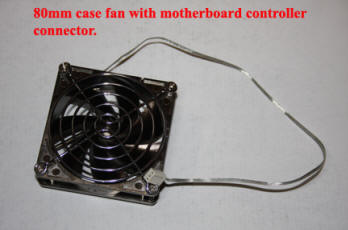

Please note that motherboard provided fan connectors are limited in the 12volt current they can supply and you should not connect a new fan to a motherboard connector until you know the motherboard can supply the current draw of the fan you are going to attach. Some fans for sale provide current draw information and some do not.
All case fans available in retail stores or over the Internet come with a standard PC power supply connector attached and then a short. optional use, PC power connector to 3 pin female connector for use with the motherboard. If a motherboard does not have fan connectors, then you simply tie the fan to your power supply. To do this, you may need a "Y" power supply connector, which are available everywhere and are cheap. Some are cheaply made so watch when you connect them that no pins get shoved out of the connector.
It is a common misunderstanding that on all motherboard's, the motherboard actually controls attached fan RPM and thus air flow. Some motherboards can control fan speed while others can not. Most case fans provided at computer retailers or available over the Internet, do not have built-in thermal control meaning that once they are hooked to 12volts, they run at their full speed constantly.
PC case fans. Noise levels: In general, the higher the RPM of a case fan, the louder it becomes. It has been my experience:
Fans with a dba or noise level defined less than about 35 are basically silent.
Fans with a dba between 35 and 60 are noticeable but acceptable.
Fans with a dba above 60 are irritating and will not last very long installed before you remove them.
Most case fans available do provide information on their noise level.
PC case fans. 80mm: It has been my experience that 80mm case fans that are basically silent do little to nothing to help either cool air into a case or hot air out of it. Seems like there are either silent 80mm fans or ones so loud you can not stand them. I don't use 80mm fans unless I have no other choice like if the PC case will only accept an 80mm in a certain location.
PC case fans. Where to add and remove: PC cases come in many different configurations with low cost models from all major manufacturers being the most restrictive on what can be done to improve cooling. Most off-the-shelf PC's rely on a CPU mounted cooling fan and a fan built into the power supply for all its cooling. Some manufacturers do go to the trouble of trying to port the CPU cooler to outside case air via a tube of some type but then cram the hard drive in a location with little or no surrounding air flow. Although simple and obvious but to keep the insides of a PC cool, you must get cool air into the case and hot air out of it. As I said, most manufacturers provide a heat exhaust fan as part of their power supply and this is supposed to drawn in cooler air through case vents or ports usually in behind the front face of the PC and does not work very well. What I have found I must do to keep PC components cool is to add a 120mm fan to the side of the PC so that the 120mm pulls ambient outside air into the case and blows it directly on the processor cooler, memory and the motherboard.
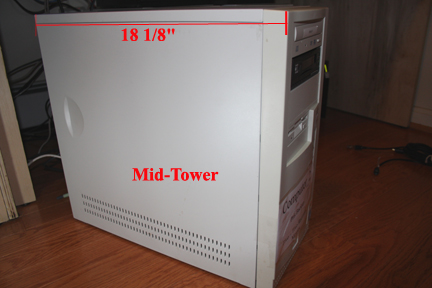
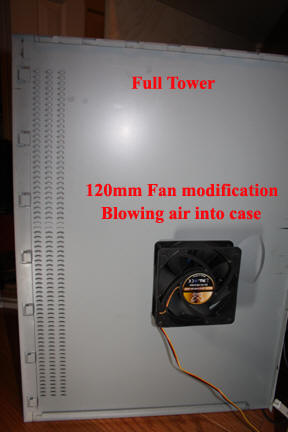
Most PC cases try to pull ambient air in from the front of the case and then exhaust out the back, with air being pulled across the hard drives and motherboard. Unfortunately, this just not work very well. If you install a fan on the back of the case strong enough to pull in ambient air and cool all inside, it is so loud as to be annoying and thus not a solution. A 120mm fan on the side of the case can move enough air over the CPU cooler and motherboard to keep temperatures in check and a small 80mm fan mounted to the back of the case helps exhaust heated air.
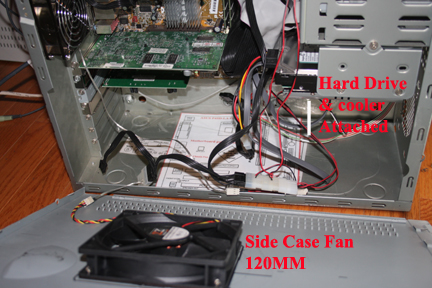
Central Processing Units (CPU) Fan: All modern processor chips require a cooling heat sink (big hunk of metal with lots of fins for heat dissipation) and a fan mounted right on the heat sink. I doubt any current processor would run for very long without cooling before it shut itself down as a self protection measure. Now the stock or standard cpu heat sink\cooling fan is made of aluminum which is not a very good conductor of heat and thus there are available all sorts of touted super cpu coolers you can buy. As I have never had the problem of keeping my cpu chip in an acceptable temperature range, I have never tried one of these super coolers to see if they really help cpu cooling or not. I would assume the ones that are made out of cooper and have many, many fins exposed to case ambient air do work well. The only problems I see with trying to go to one of these super cpu coolers is: (1) which one fits the cpu socket you have? Intel and AMD have changed chip socket designs so many times that you really must know what socket you have and thus cooler mounting arrangement before you can buy and install a super cooler. Unfortunately, most off-the-shelf systems do not provide socket type information in standard materials provided when you buy the computer. (2) Super cpu coolers are larger in size that stock coolers and so you have to be careful to make sure the super cooler will physically fit into your computer. Most PC cases have the power supply mounted directly above the cpu and associated fan and a much larger heat sink cooler may not physically fit. (3) Although replacing a stock cpu cooler is not difficult, it does require you to "unhook", how ever attached, the old cooler and then "snap" into place the new super cooler. Here, great care is required as the stock cooler is going to be down tight against the cpu chip and if you use a screwdriver to pry or move the cooler, you could easily slip off the cooler and damage a motherboard component.
CPU Fan. Thermal Conductive Paste: If you replace your current cpu heat sink and fan with a new one or your cpu is running to hot no matter how many fans you add to the case or other measures you take, you are going to want to use what is known as silicon thermal conductive paste between the top of the cpu chip and the bottom of the heat sink. It is amazing to me that I have never found an off-the-shelf system with any sort of paste between the cpu and the attached cpu heat sink. Guess it just too much trouble for the manufacturer to go to, to deal with messy paste. Thermal conductive paste is available at Radio Shack and other computer retail or Internet sources.
Hard drive fans: Modern, large capacity, hard drives can really heat up if there is insufficient air flow around them and high heat can potentially result in hard drive failure. There are 3 things you can do to reduce hard drive heat: (1) If possible mount the drive inside the case such that it has plenty of air space around it. Some off-the-shelf PC's mount the hard drive so it has little or no air space and you may not be able to move the drive. (2) Even with air space around the drive, I find it best to add a hard drive cooler right to the underside of the drive. This little fan and associated heat sink can drop hard drive temperature 10 degrees or more. (3) Do not use any sort of bay hard drive enclosure. For a while I had one of my SATA drives mounted in an enclosure to help with mounting a 3.5" drive in a 5.25" bay but what I found was, although the enclosure has a small fan in the bottom to keep the drive electronics cool, the enclosure did not allow enough case ambient air around the drive and thus the drive would get into dangerous heat territory. I liked the enclosure but had to remove.
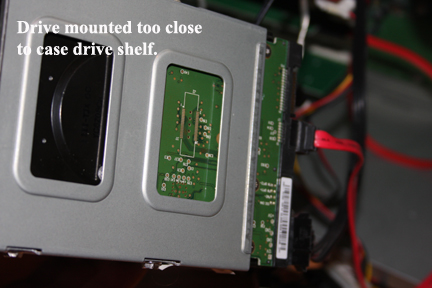

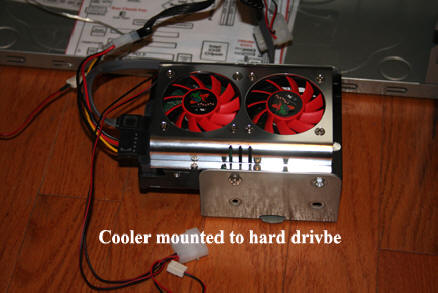
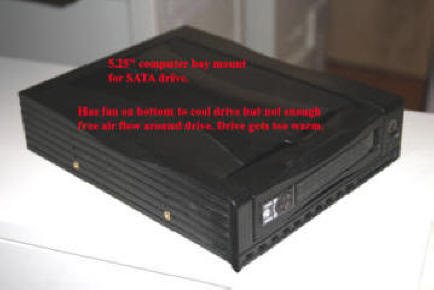
PC fans. Video board: Video boards, especially the expensive, incredibly fast type used in gaming, generate a ton of heat. Most of these boards come with a fan built onto the card but I know that special video board coolers are sold as an add-on. I have never bought or tried one of these video board coolers but assume they help significantly in keeping the board electronics cool. The problem with any video board installed is that it does not have any sort of special port to ambient outside air or any dedicated port to exhaust all the heat it generates. In my case, the video boards I use do generate heat but my solution is the side of case mounted 120mm fan blowing outside ambient air over the cpu cooler, memory and the video board. Again, I use a rear mounted case fan to exhaust heat and also install a vented, PCI slot, blank just below the video board to help exhaust heat specifically generated by the video board.
PC fans. Internal case air flow: As I said above, to keep a PC cool, you must get ambient outside air into the case constantly and constantly exhaust case interior heat. I believe that 2 fans are needed to accomplish this. But simply adding a fan to the side of your case without examining what is going to be the resulting air flow might not provide the results expected. On the generic PC case I have, both the mid tower and the full tower have vented chassis front panels behind the plastic cosmetic face. Both the mid tower and the full tower have louvers on one side or the other and the full tower has louvers on both sides. Both the mid tower and the full tower have a place for a 80mm fan to be mounted on the back to exhaust out hot air. The full tower has one 80mm port down in the motherboard section of the case and another 80mm exhaust port above the power supply. So ok, lots of louvers for air flow but what I have found that I have had to close off some louvers to get the air flow I want inside the PC case.
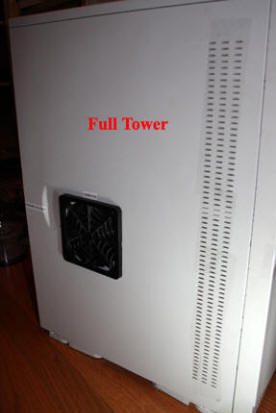
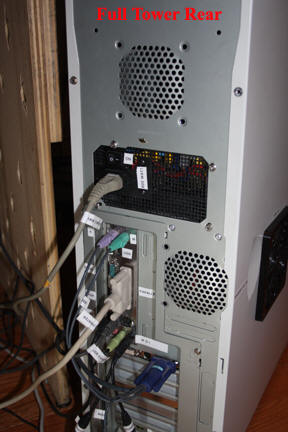
On the full tower, I do not want ambient outside air blowing out the louvers on the side with the fan or on the case opposite side as outside air will not be pushed like I want over the cpu cooler and memory and hard drives. I want air forced in from the side to exhaust out the front over the hard drives mounted there and out the rear. To do this, I tape off the louvers on both sides of the full tower case. I also do not want side mounted fan air to exhaust out the top port on the full tower and so I have taped it off. I have mounted a fan there but it had little or no effect and in fact, seem to actually cause an increase in PC component temperatures.
On the mid tower case, it has louvers on the side with my installed 120mm fan at the bottom and no louvers on the opposite side. Again, I want 120mm fan air to blow over the cpu and memory and be exhausted out the front and rear of the case. So, I tape off the louvers on the fan side of the case.
Finally, besides the power supply, which is pulling air up out of the case and exhausting out the back and a 80mm fan I have installed inside the case exhausting air out the rear, I have installed a vented, PCI board slot, blank just below the AGP video card. Heat then from the video card is pushed out this vent to the rear of the case.
PC fans. Powering: Probably just me but I do not power any fan off the same power supply cable hooked to a disk drive, floppy, CD/DVD or another other device. Fans can put "junk" on the 12 volt line and although all power supply lines terminate at the power supply and thus "are connected" there, I just want to reduce the chance that a 12 volt adversely effects a hard drive.